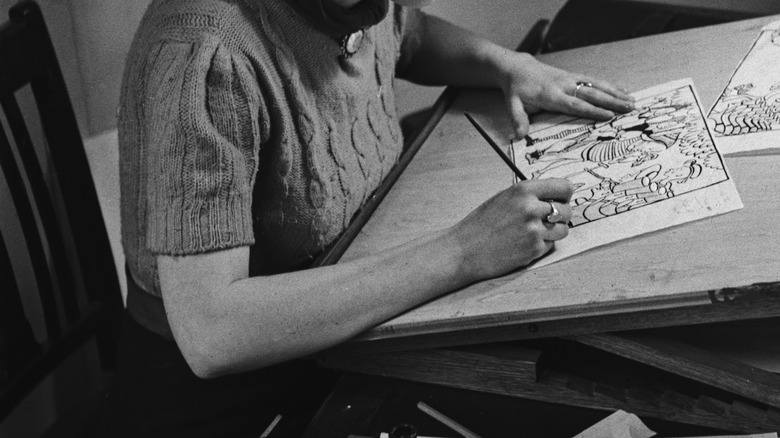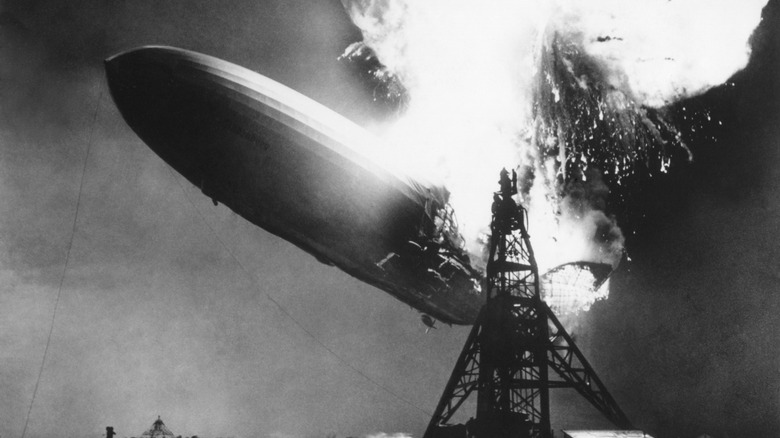Why The Meaning Of A Lead Balloon Might Not Be As Accurate As We Thought
In his Socratic dialogue essay "The Decay of Lying," Oscar Wilde wrote, "Man can believe the impossible, but man can never believe the improbable" (via Project Gutenberg). Wilde bemoaned the human obsession with unlikeliness and improbability, so he might have rolled his eyes at the popularity of dubious musings such as "when pigs fly." Twenty-four years after Wilde's death in 1900, a famous American cartoonist, Loren Taylor, produced a comic strip that said a character's stock investment "was about to go up as fast as a lead balloon" (via WordHistories). The Science History Institute states that the phrase gained popularity after World War II when Americans and Brits utilized the simile to indicate something was destined to fail or go belly up.
Speaking of Brits, Keith Moon of The Who infamously told a young Jimmy Page that his newly formed music project had no chance of success (via Far Out Magazine). Page took Moon's warning of "this band will go over like a lead balloon" a step farther and ironically chose the ultimate balloon to name his project after — Led Zeppelin.
The saying, however, isn't wholly accurate. Despite memes putting pigs in pilot seats to show they can fly, we know pigs have yet to develop wings. But lead balloons are a different story.
The funny origins of lead balloons
The cartoon from Loren Taylor in 1924 incorporated the statement "going up like a lead balloon," and could be read in a different context during the roaring '20s than in a post-World War II era and beyond (Science History Institute). The latter interpretation of Taylor's cartoon dialogue is a bit misguided — that the stock was going down. In 1924, when Taylor's toon was published, the stock market actually went up at a tremendous rate for a solid five years until the crash of October 1929. The usage here implies, on behalf of the comic strip character, that there are better alternatives out there to invest in than the Twin Eight Engine company, which would probably just hover at the stock price and struggle for momentum to rise like the rest of the market.
The original cartoon, which suggests the stock would be hard to generate a "quick buck," reads more as a commentary on the original stock broker character's assessment than an overall read on the stock market trends of that year. After the cartoonist's publication and post-Depression and post-WWII, the phrase hovered between British and American interpretations. The British referenced specifically the bombs that fell on their cities as lead balloons while Americans utilized the term as a means of explaining away failed business ventures in a scrambling economy (via Oxford Dictionary of Word Origins).
Scientists have tried to prove the saying wrong
In 1937, the Hindenburg dirigible airship was a colossal disaster, but was incidentally eventually utilized by Led Zeppelin for its first album cover (via Express UK). Designed as a luxurious form of transportation for TransAtlantic travel, it was said to have gone over like a lead balloon, underscoring the tragedy of over 35 casualties. The idiom is defined by Oxford Learner Dictionary as "to be very unsuccessful; to not be accepted by people." However, there was a time that a lead balloon actually did successfully go over people's heads.
In 1977, chemist Jim Birkett was doodling at his desk and wondering about lead balloons (via Science History Institute). He decided to challenge his colleagues to a contest: see if they could make a lead balloon fly. It's a good thing Birkett worked for Arthur D. Little, a chemistry firm named after its founder. In 1921, Little recalled the words of writer Jonathan Swift, who said, "You cannot make a silk purse from a sow's ear," and invited his fellow chemists to challenge Swift's adage. Fortunately, his workplace had 100 pounds of melted pigs' ears at their disposal which were turned into glue and eventually fiber in a successful act of synthesis. Little's team successfully created two purses from the glue.
Motivated by this, Birkett tackled another improbable feat. The lead balloon popped into his head and thus submissions were open for scientists to prove they could be airborne.
A lead balloon really went over many heads
On May 16, 1977, three of the successful challengers put their balloons to the test in front of their colleagues and the press (via Science History Institute). The balloons were relatively large but only one was shaped like a zeppelin. Like a psychedelic STEM project, the zeppelin was composed of lead foil over a cylinder-shaped wooden frame. As the race kicked off, the two balloons fell to the earth but the zeppelin caught a gust of wind that snapped it from its tethers and sent it towards Logan Airport.
Birkett had to call the airport's control tower to warn them but they already knew — they were watching the experiment on television. The balloon vanished and drifted towards Europe. No one knows where it is today but the lead balloon successfully went over many heads and homes. But this wasn't the last time a lead balloon would be triumphant.
Lead balloons have gone up more than once
In June 2008, the Discovery Channel show "MythBusters" tackled the proverbial lead balloon experiment (via IMDb). Host Adam Savage wanted to even out the lead as much as he could. He used a large plastic drop cloth to parse out the helium with the lead, although he worried about tears and sudden lifts from too much buoyancy (via YouTube). Inevitably, the tears occurred, but Savage continuously patched the origami square-like zeppelin. However, with a few blasts of helium, the balloon took off like ... well ... a lead balloon.
Savage laughed, "While this might be ridiculously impractical ... if someone says something is impossible we just take it as a challenge. Idiom busted!" At the end of the experiment, the hosts destroyed the balloon with baseball bats. The Discovery Channel team and Jim Birkett have now both proved that the turn of phrase to go over like a lead balloon is actually inaccurate. With a ton of elbow grease and enough helium and air, a lead balloon can certainly go up.




